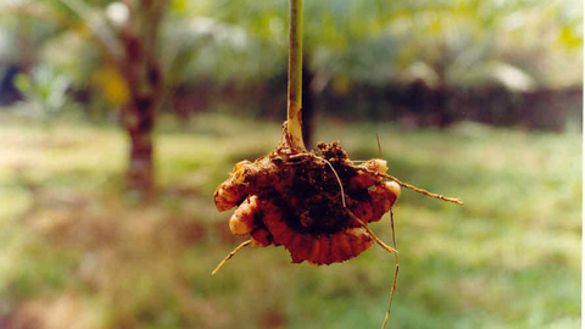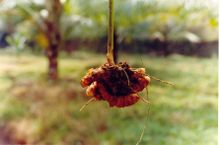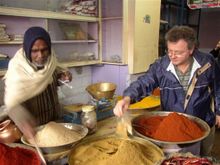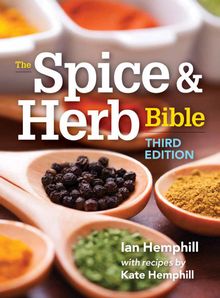 19 Jul 2017
19 Jul 2017
Tags: healthy spices, turmeric

Whatever you believe about turmeric (and a Google search will give you lots of pros and cons), we believe it is a wonderful spice, and one that can be enjoyed culinarily in many different ways.
We are not health practitioners, as our expertise relates only to our knowledge of the growing, harvesting, processing and uses of spices and herbs in foods.
Therefore, we thought that a thorough explanation (adapted from my 2006 edition of Spice Notes and Recipes) of turmeric would be useful, and we have included lots of Turmeric information in our latest Blog.
Turmeric is the rhizome (the part of the root system that grows off the primary tuber) of a tropical perennial plant which, for harvesting purposes, is grown as an annual. Turmeric has long, flat, bright-green leaves growing up from the base to 1 m high and looks similar to ginger, and some lilies with its pale-yellow flowers. The rhizomes, which are commonly referred to as fingers, are ginger-like in appearance and 5–8 cm long. They are rounder in cross-section than ginger, measure 1.5 cm thick and are deep orange–yellow in colour. Powdered turmeric is bright yellow, has a distinct earthy aroma and surprisingly pleasing, sharp, bitter, spicy, lingering depth of flavour.
Origin and History
Turmeric is not known in a truly wild state and is believed to have evolved from wild Curcuma through a process of continual selection and cultivation by vegetative propagation of the fingers. Curcuma is indigenous to Southern Asia, where it was domesticated and featured prominently in both medicinal and religious applications there. Turmeric was listed in an Assyrian herbal in 600 BC as a colouring and had reached China by the seventh century AD. Marco Polo described it as occurring at Koncha in China in 1280, noting its similarity to saffron. One wonders whether the young Marco had been sampling some more interesting substances to come up with such a deduction, for besides colour, there is little saffron and turmeric have in common. Even the bright yellow of turmeric is quite different to the golden orange–yellow of infused saffron.
Turmeric was known in the Malagasy Republic (Madagascar) in the eighth century and by the 13th century was being used as a dye in West Africa. Turmeric is a spice that features in Ayurvedic medicine, the traditional 'natural' medicine of India, and is said to be a mild digestive. Ointments based on turmeric are applied as an antiseptic, and turmeric water is an Asian cosmetic that is said to be good for one's skin. Turmeric is used extensively as a colouring in foods (including confectionery and pharmaceuticals) in response to the increasing consumer demand for natural colours.
Yellow turmeric paper can be used as a test for alkalinity, which turns it brown. The textile industry has also used turmeric for many years as a dye, even though by today's standards it is not at all fast. It is likely that as the price of turmeric is pushed up with greater culinary use, longer-lasting synthetic dyes will replace it.
Processing
After the turmeric rhizomes have been lifted, they are put into boiling water for about an hour. This has the effect of speeding up the drying time and de-naturing them, so they will not sprout. It also aids even distribution of colour in the rhizome; when fresh turmeric is cut, one will notice the orange–yellow colour is not evenly distributed in the cross-section. The fingers are then dried in the sun – a gelatinisation of the starches during boiling makes them rock-hard, and this is why they are almost impossible to grind domestically.
Once dry, the fingers are polished to remove the outer skin, rootlets and any remaining soil particles. The traditional way to polish turmeric fingers was for workers to wrap their hands or feet in several layers of gunny sack to provide abrasion (as well as protection for the worker) and to then rub the turmeric vigorously. Another method was to put the turmeric fingers in a long gunny sack with some stones. Two workers would then shake the bag between them (in the same way you would wave a beach towel to get the sand out of it) transforming the dirty brown rhizomes into smooth, dark-yellow fingers ready for market. Nowadays polishing is performed in large wire or perforated-metal drums that are rotated on an axle, so the rubbish falls out through the holes and the polished fingers are left behind in the drum.
Ground turmeric is made by first crushing the slate-hard fingers in a hammer-mill, then transferring them to a grinder set up to produce the familiar, bright-yellow powder. Turmeric oleoresin is extracted for use as a natural colour (E100) in the food and pharmaceutical industries, where it is sometimes referred to as curcuma oleoresin.
Buying and Storage
An increase in the popularity of Asian foods in Australia and the United States of America, which began in the 1980s, helped cooks to become aware of the virtue of using fresh turmeric rhizome for its colour and flavour. Fresh turmeric is often available from specialty produce merchants, particularly those that cater to the Asian market. The rhizomes should be plump, firm and clean. Store fresh turmeric in an open container in the cupboard, in the same way as you keep your fresh onions and garlic, where it will last for up to two weeks. Turmeric leaves (used in Malay and Indonesian cooking) and the young tender shoots for Thai dishes are also available from Asian produce stores.
There are two main types of turmeric powder: Madras and Alleppey It is interesting to note that many spices have prefixes derived from geographic regions, however, this does not necessarily mean that is where they are grown. The name may be given because a certain grade or type of the spice was always available from the traders in a particular area or perhaps the district the spice was named after had become better-known than other areas for producing it. Madras turmeric is grown in Tamil Nadu (in India) and is traded mostly in Madras. Alleppey turmeric is produced in Kerala, and takes its name from the beautiful, waterway-laced Alleppey district near Cochin, where much of this turmeric is traded.
Madras turmeric is light yellow and has been the most commonly available variety for culinary use. The English regarded it as the superior grade (probably because it colours without contributing much flavour) and Madras turmeric has been used primarily to colour curries, mustards and pickles. Madras turmeric has a curcumin (the colouring agent) content of around 2.5%.
Alleppey turmeric is much darker in colour. Its curcumin content on average at 5% and may be as high as 6.5%, making it a more effective colouring agent with superior fresh turmeric flavour notes. Alleppey turmeric more closely resembles the flavour of fresh turmeric and has a somewhat earthy aroma with surprisingly delicate top notes of lemon and mint, reminiscent of its cousin, ginger. The texture is 'oily' due to the higher curcumin content, and when blending with other spices I suggest sieving it through a small strainer to prevent clumping.
The popularity of beverages other than tea and coffee, has seen a resurgence in the consumption of herbal teas and spiceed drinks such as Chai. We now make a delicious Turmeric Chai that is made only from spices that compliment the flavour of turmeric. It is easy to make and is a great alternative to a cappuccino or latte.
Fresh compared to Powder
Fresh turmeric is grated into many Asian dishes, and used in making commercial and home-made pastes. Turmeric powder will always be much stronger, as the water content has been significantly reduced on drying, and the drying process concentrates the active ingredients. Should you wish to use turmeric powder as a substitute for fresh, use about one quarter of the amount in the recipe for fresh. For example, for 4 teaspoons of grated fresh turmeric rhizome, substitute with 1 teaspoon of turmeric powder (preferably Alleppey).
Although turmeric is often called Indian saffron, turmeric should never be used in a recipe as a substitute for true saffron, as the flavour is quite different. One can make an attractive and tasty yellow rice dish, though, with turmeric. When cooking by absorption, for every cup of rice covered with water, add 1⁄2 tsp of turmeric powder, a 4 cm quill of cinnamon, 3 whole cloves and 4 green cardamom pods.
Always be very careful not to spill turmeric on your clothes, as it will leave stains that are almost impossible to remove!






